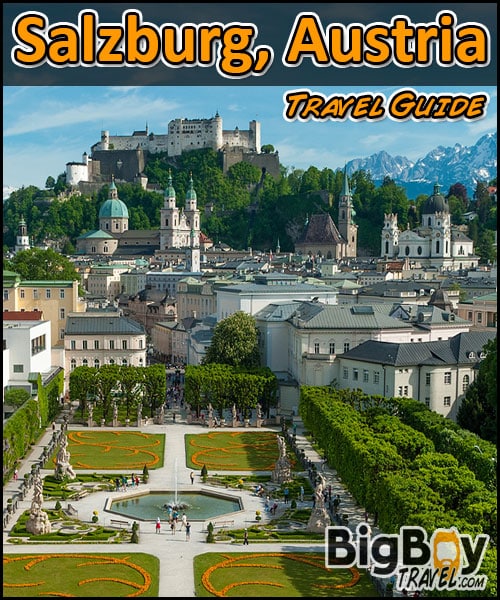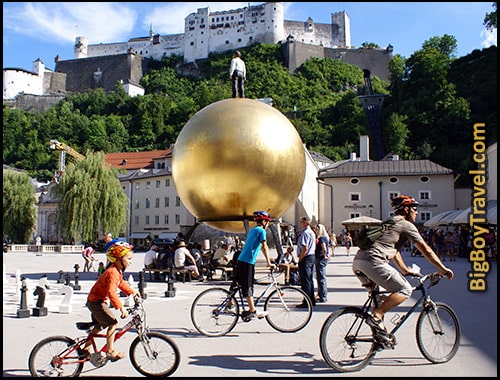Salzburg, Austria:
Meaning: Salzburg (German) means Salt Castle
Settled In: Neolithic Era on Kapuzinerberg; continuous settlement by the Celts by the 5th century BC; concentrated by the Romans in 15 BC as Juvavum (covered all of old town by 30AD, municipal in 45AD); modern city established in 696; renamed Salzburg by 755; given free commune status (Imperial City) in 1287.
Governed By: Prince-Archbishop from 1328-1803; annexed into Austria in 1805 then Bavaria in 1810, then back to Austria in 1816; Austro-Hungarian Empire 1867-1918; Austria 1918-1938; annexed in Germany 1938-1945; back to Austria again.
Language: German (Deutsch) with some very basic English
Suggested Length of Stay: Salzburg is a city that you can tour the heart of in 1 day, but we suggest 2-3 full days to really get the best experience.
Overview of Salzburg:
Gaining wealth from the surround salt mines, Salzburg has been able to stay out of most wartime conflicts to remain one of the most well preserved Central European cities. Salzburg is scenic, cozy, and home of Mozart, the beautiful Mirabell Gardens & Palace, and the backdrop for The Sound of Music. While it might seem quaint, the city tucked into the Alps is actually the fourth largest city in Austria.
Our FREE Salzburg Tours:
There is a ton to do in and around Salzburg and you can get the most out of your trip by following our free walking tours.
1. Old Town Salzburg Free Walking Tour
2. Sound of Music Movie Locations Tour
Top 10 Things To Do In Salzburg:
1. Visit The Mozart Sights
2. See The Sound of Music Film Locations
3. Tour Salzburg High Fortress
4. Explore St Peter’s Church & Cemetery
5. Shop On The Medieval Getreidgasse
Read More: Top 10 Things To Do In Salzburg
History Of Salzburg:
Neolithic Era on Kapuzinerberg; continuous in the area by the Celts by the 5th century BC; concentrated by the Romans in 15 BC as Juvavum ( municipal in 45AD); municipium Claudium Iuvavum was official name making it the first urban settlement with the right to self-administration north of the Alps. yet still behind the frontier at 90km from the Danube
It was an important traffic junction a) for the continuation of the Salzach road N in the direction of Castra Regina (Regensburg) and b) for the Noric road in the direction of Ovilava (Wels) and Launiacum (Lorch-Enns) on the Danube limes. Iuvavum never was a garrison and did not have walls but did flourish, a large necropolis on road out of town across the river on Linzergasse,
Emperor Nero (AD 54-68) covered all of old town; left to right by 30AD
destroyed in the Marcomannic War in 171 against Germanic tribes (Markomans and Quads); rebuilt over 25 years.
with forum and capital believed to be in the center, Residenzplatz of an altar to Jupiter and all the gods, blocks found from the time of Septimius Severus, eastern forum had Temple of Asklepios found on the curve of Kaigasse 45.5 meters long and 29.6 meters wide since many pertinent sculptures have been found in this area (statuettes of Asklepios, of Hygieia, a votive altar for Asklepios Augustus, a Serapis head),
Residenzplatz they found ruins of Roman buildings, walls, road, and Weihealtar with an inscription of the river god “Iuvavus”
Petersfriedhof catacombs and tunnels under Nonnberg go back to Roman times, in Roman times Nonnberg was a Hercules and Mercury Shrine.
Germanic Western Roman officer Odoacer disposes of last Western Roman Emperor in 476 and calls himself the 1st King of Italy. Conflicts with Germanic Rugii tribes areas north of Alps are abandoned by Romans around 488AD who retreat leaving the Romano-Celtic locals who are joined by members of the Germanic Bavarii tribes
in 696AD Saint Rupert (Frankish missionary & Bishop of Worms) was given castrum superius or Salzpurch (hill fort) by the Duke of Bavaria in the capital of Regensburg and founded Salzburg by building Saint Peter’s monastery on the site of an older church of Stiftskirche by Severinus of Noricum known as St. Severin (410-482)
Nonnberg nunnery (711 by his sister Erentrudis) world’s oldest continuous Christian women convent; the fort was basically where Nonnberg is today with a small settlement (oppidum) below;
Rupert died in Worms in 718. His bones were transferred to Salzburg by the holy Bishop Virgil on the occasion of the inauguration of the new building of the Salzburg Cathedral on 24 September 774.
996 gain market rights by Emperor Otto II
1006 first Nonnberg Monastery burns and a new one built (rebuilt again after fire 1464 to 1509), High Fortress in 1077
present-day Romanesque Saint Peter’s Abbey from 1130 or 1167 over a Carolingian church from the 800
As early as 1287 the citizens of Salzburg were granted (political) rights for the first time with the Letter of Atonement.
1331 first Rupert’s feast
Independence from Bavaria was secured in 1328 followed by the building of the walls and Franziskener-Church (1408) under the rule of the Prince-Archbishops
1481 twice a year markets allowed.
1500-1600 baroque buildings, and was the 2nd largest church state in Europe behind the Vatican
domed church fire in 1598 and the square is redone in Italian style, Salzburg Cathedral consecrated 1628 (also 774 & 1959, shown on wrought-iron gates )
The many treasures of this cathedral include a bronze baptismal font (1311) with lions at its base (1200), in which Wolfgang Amadeus Mozart and Joseph Mohr, the man who wrote the words for “Silent Night!” baptized
The very first cathedral was built in 767 under bishop Virgil, subsequently consecrated to Saints Peter and Rupert in the year 774. After a fire in 1167, Archbishop Konrad III had the cathedral rebuilt, now more magnificent than ever, with the work completed in just ten years: now the mightiest Romanesque minster north of the Alps. The remains of these two former churches can still be viewed in the cathedral crypt.
1756 Mozart born in the Hagenauer House were the family had a 3rd-floor apartment since 1747, later moved to the Residence in 1773
1805 annexed into Austria along with Berchtesgaden, but then both to Bavaria in 1809 until Austria sent back in 1816. 1818 bad fire and Silent Night played in in St. Nikolaus’ Church, Oberndorf on Dec 25th
1852 Café Tomaselli, first Salzburg Festival 1920, Germany 1938, 7600 homes bombed in 1944 along with bridges and cathedral dome.
Today Salzburg still has 50 churches ranging in style from Romanesque and Gothic to Baroque.







